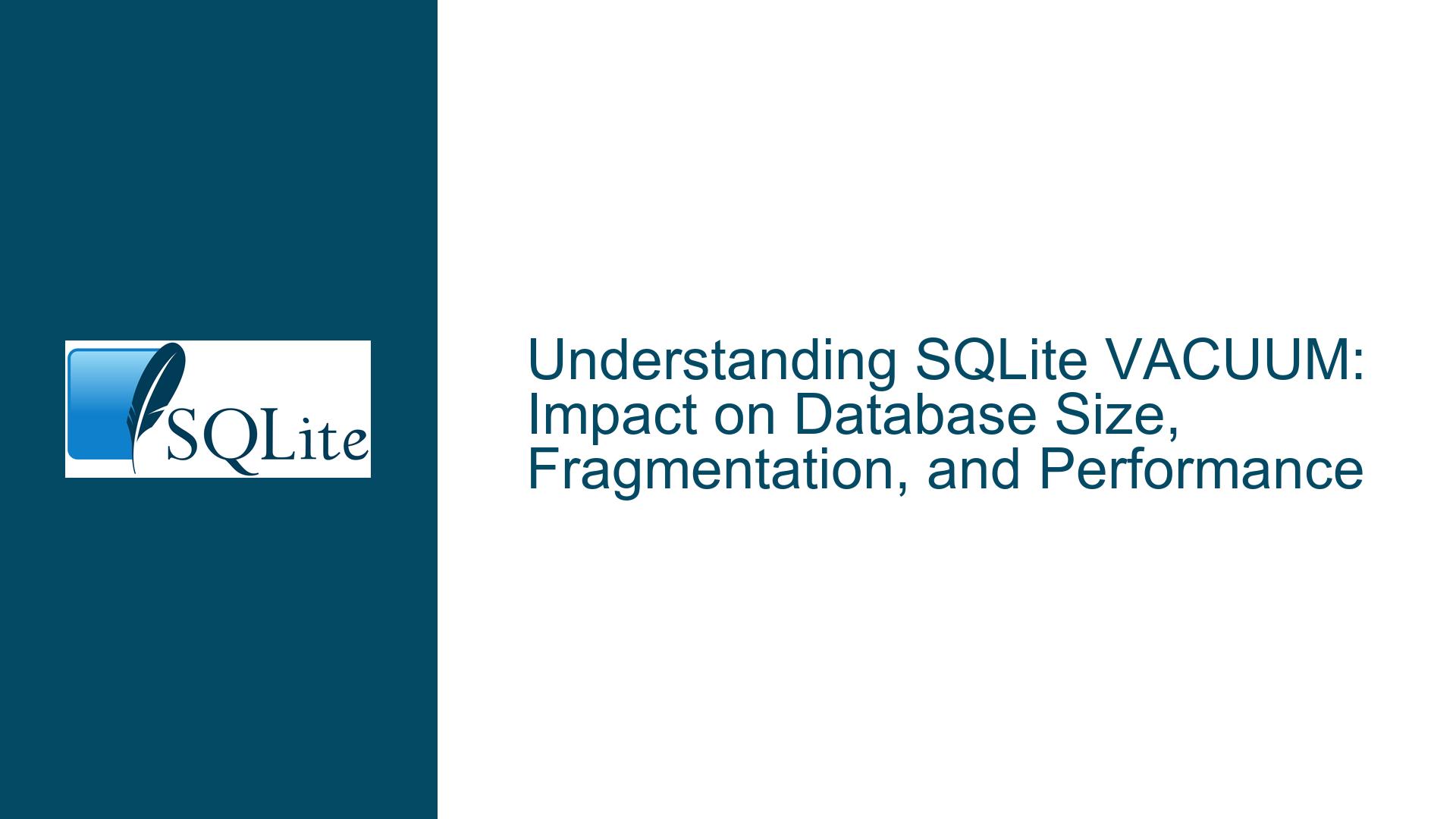SQLite VACUUM: Impact on Database Size, Fragmentation, and Performance
VACUUM’s Role in Database Size Reduction and Fragmentation Management
The SQLite VACUUM command is often misunderstood as a simple "cleanup" tool for reclaiming space from deleted rows. While its primary function is to rebuild the database file to eliminate unused space (often called "holes" or fragmentation), its impact extends beyond basic space reclamation. To fully grasp its utility, we must dissect SQLite’s storage architecture and how VACUUM interacts with it.
SQLite stores data in fixed-size pages (default: 4KB). When rows are deleted, entire pages or portions of pages become free. These free regions are tracked internally via a freelist, a linked list of unused pages. Subsequent INSERT operations reuse these pages, but reuse efficiency depends on the size and alignment of new data. For example, inserting a 2KB row into a partially free 3KB page is straightforward, but inserting a 5KB row may require splitting data across multiple pages or allocating new pages.
The VACUUM command rebuilds the entire database into a new file, effectively serializing all active data into contiguous pages. This process eliminates fragmentation at both the page and file levels. However, two critical questions arise:
- Does
VACUUMoptimize data structures beyond space reclamation?
The rebuild process reorganizes tables and indexes into their most compact form, which can improve locality of reference. For instance, B-tree structures (used for tables and indexes) are rewritten to minimize depth and balance node distribution. This can marginally improve query performance by reducing the number of page traversals required for index lookups. - Is defragmentation irrelevant for non-mechanical storage?
While SSDs lack mechanical seek delays, fragmentation still impacts performance in two ways:- I/O Throughput: Even SSDs benefit from sequential reads. A fragmented database may require more I/O operations to fetch scattered pages, increasing latency.
- Caching Efficiency: Smaller, contiguous databases are more likely to fit entirely in memory (e.g., SQLite’s page cache or the OS disk cache). For example, a 20MB database might be fully cached, while a fragmented 50MB database with 30MB of free space could exceed cache capacity, forcing frequent disk access.
In scenarios where databases are larger than the available cache (e.g., mobile devices with limited RAM), VACUUM can reduce the working set size, enabling more efficient caching. This is particularly relevant for applications storing large BLOBs, as seen in the forum discussion where compressing text blobs reduced the database from 20MB to 2MB, allowing full caching and eliminating disk reads.
Factors Influencing VACUUM Necessity and Performance Overheads
The decision to run VACUUM hinges on trade-offs between storage efficiency, performance, and hardware constraints. Key factors include:
1. Write Amplification and SSD Wear
VACUUM rewrites the entire database, which on SSDs causes write amplification—the same data is written to new flash cells, wearing out the drive prematurely. For databases with frequent small deletions, the natural reuse of free pages during normal operations is preferable to periodic VACUUM runs.
2. Transactional Overhead
The VACUUM process requires an exclusive lock on the database, blocking all other operations during execution. For large databases (e.g., gigabytes in size), this downtime can be prohibitive. Additionally, VACUUM doubles storage requirements temporarily, as it creates a new database file before deleting the old one.
3. Fragmentation Thresholds
SQLite’s freelist management efficiently reuses free pages, but fragmentation becomes problematic when:
- Large Deltas: As mentioned in the forum, databases undergoing massive insert/delete cycles (e.g., 100s of MB added and removed) may accumulate free pages faster than they can be reused.
- Non-Uniform Data Sizes: Tables with variable-length data (e.g., text blobs) are prone to partial page fragmentation, where free space exists but cannot accommodate new rows.
4. Cache-to-Database Ratio
If the database size exceeds the available cache (e.g., Android devices with 1GB RAM handling a 2GB database), VACUUM can shrink the file to fit within cache limits, reducing disk I/O. Conversely, if the database is already cache-resident, defragmentation offers minimal gains.
5. Backup and Transmission Needs
VACUUM is justified when preparing databases for backup or transfer over networks, as it minimizes file size. For example, compressing a vacuumed 2MB database is faster and more efficient than a fragmented 20MB file.
Optimizing VACUUM Usage: Scenarios, Trade-offs, and Best Practices
To determine when and how to use VACUUM, follow these guidelines:
Step 1: Assess Fragmentation Levels
Use the sqlite3_analyzer tool to generate a report on free pages and fragmentation. Key metrics:
freelist_count: Number of completely free pages.overflow_pages: Indicates row-level fragmentation (rows spanning multiple pages).avg_fragmentation: Percentage of free space within used pages.
Example command:
sqlite3_analyzer database.db > report.txt
Step 2: Evaluate Performance Metrics
Monitor query performance before and after VACUUM. Use EXPLAIN QUERY PLAN to identify changes in page reads. For instance, a full table scan that previously required 10,000 page reads might drop to 8,000 post-VACUUM due to contiguous storage.
Step 3: Implement Incremental VACUUM
For large databases, enable incremental vacuuming via PRAGMA auto_vacuum = INCREMENTAL;. This allows reclaiming space in smaller chunks during idle periods, avoiding long locks.
Step 4: Schedule VACUUM Strategically
- SSD-Based Systems: Run
VACUUMonly when necessary (e.g., before backups). - HDD-Based Systems: Schedule monthly vacuuming if fragmentation exceeds 20%.
- Mobile Devices: Use app downtime (e.g., nighttime) to run
VACUUMwhen the database is inactive.
Step 5: Optimize Schema and Queries
Reduce reliance on VACUUM by:
- Using
DELETEsparingly; prefer soft deletes with ais_deletedflag. - Avoiding variable-length columns where possible; use
TEXTinstead ofBLOBif compression isn’t required. - Employing
PRAGMA page_size = 8192;to align page size with OS I/O blocks (reduces partial page waste).
Step 6: Leverage Alternative Mechanisms
- WAL Mode: Write-Ahead Logging reduces contention during
VACUUMand improves concurrent access. - Manual Freelist Trimming: Use
PRAGMA shrink_memory;(on supported builds) to release free pages without full vacuuming.
Final Considerations
- For databases under active development, benchmark
VACUUMimpacts using tools likesqlite3_benchor custom scripts. - Educate teams on SQLite’s internal space reuse mechanisms to prevent unnecessary vacuuming. As noted in the forum, free pages are reused before expanding the database file, making
VACUUMredundant in most delta-heavy workflows.
By aligning VACUUM usage with specific operational needs and hardware constraints, developers can balance storage efficiency, performance, and longevity of their SQLite databases.






